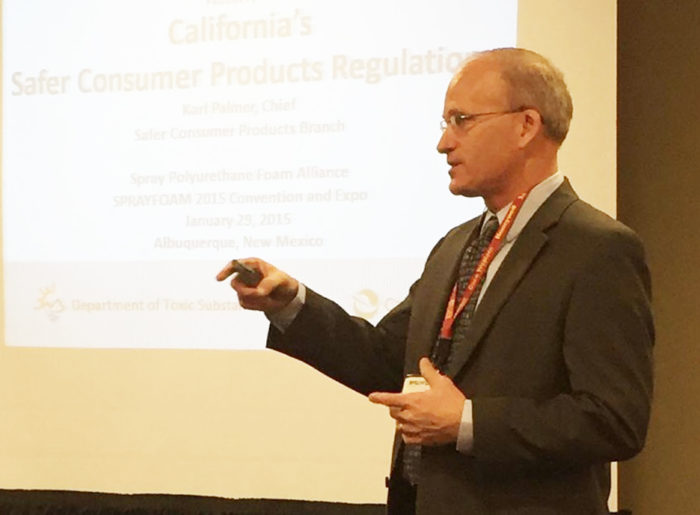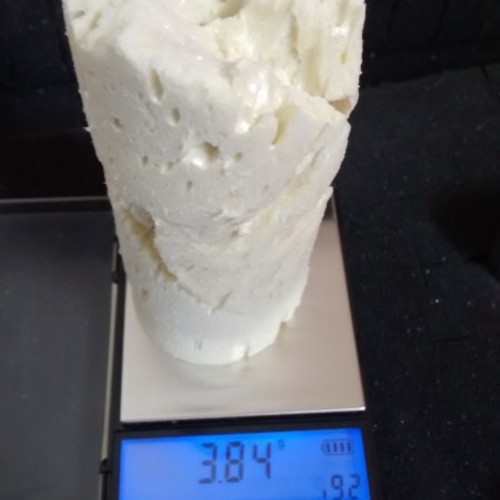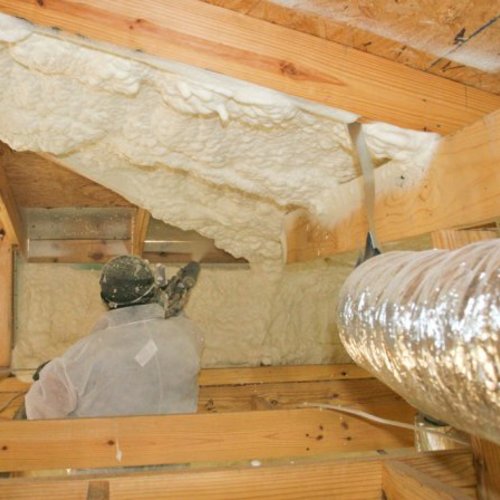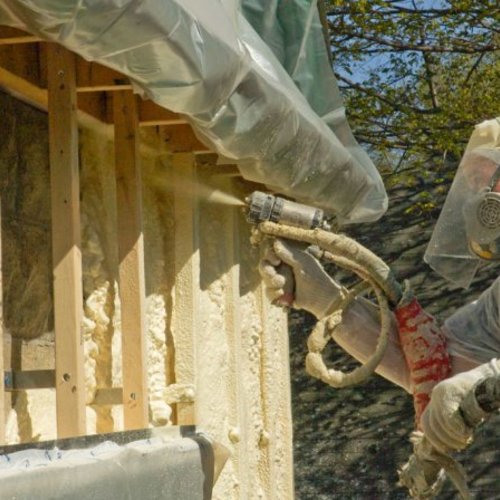
Image Credit: Energy Vanguard
Last summer I learned about the state of California’s efforts to create more healthful buildings and working conditions. In 2008, they passed the California Green Chemistry Initiative with the intent of reducing state residents’ exposure to toxic chemicals.
California leads the U.S. in new directions all the time, and green chemistry could be another. Unfortunately, though, they were slow out of the gate and their initial attempts to implement the law don’t instill confidence.
The Safer Consumer Products Program
I’ll distill this issue down as much as I can because it’s easy to get confused if you dive in and try to figure it all out. First, the Green Chemistry Initiative, also called the Green Chemistry Law, contains six recommendations. (Karl Palmer,1 an administrator at the California Department of Toxic Substances Control who’s pictured in the photo at right, specified the California Assembly bill numbers as AB 1879/SB 509.)
The Safer Consumer Products Program stems from recommendation number 5: “Accelerate the quest for safer products.”
Here’s how it works.
Step 1
The state puts together a list of “candidate chemicals.” The Department of Toxic Substances Control (DTSC) website says there are about 1,200 chemicals on the list.
Step 2
The DTSC identifies products that use those chemicals and singles out any that they believe should be scrutinized further. These are called Priority Products. In March 2014, after six years of trying to implement Green Chemistry Initiative recommendation #5, they finally announced the first three Priority Products:
The DTSC writes a Priority Product Profile for each one, giving the scientific reasoning behind its inclusion on the list.
Step 3
The “responsible entities” for a Priority Product must then do an Alternatives Analysis to see what they might be able to do to make their product safer.
Step 4
California then decides what regulations to impose on Priority Products.
The acronym and initials soup
I’ve already given three of them above, but there are plenty more acronyms and initials that you’re likely to run across when you start reading about this. Here are the main ones I’ve seen bandied about:
DTSC – Department of Toxic Substances Control SCP – Safer Consumer Products (Program) SPFA – Spray Polyurethane Foam Alliance ACC – American Chemistry Council CC – Candidate Chemicals PPP – Priority Product Profile SPF – Spray polyurethane foam MDI – Methylene diisocyanate TDI – Toluene diisocyanate HDI – Hexamethylene diisocyanate AA – Alternatives Analysis PPE – Personal protective equipmentThe DTSC mistake-fest
At this point, California is still on Step 2. They’ve identified the first three Priority Products and written profiles on them. The one I’m interested in is spray polyurethane foam insulation, and the DTSC released the initial profile on March 13, 2014.
I say “initial profile” because six months later they released a revised version of the SPF Priority Product Profile. And when I say revised, I mean seriously marked up and changed. Why? Because it was full of mistakes.
The two biggest mistakes, which could be considered fatal flaws, are:
- The DTSC assumed that spray polyurethane foam contains two chemicals that aren’t in it. It has methylene diisocyanate (MDI), not hexamethylene diisocyanate (HDI) or toluene diisocyanate (TDI).
- Much of the documentation on health effects cited in the profile did not apply to SPF. As a result, their strong statements on the problems with SPF had to be toned way down.
If you download and read the revised report, you’ll see what I mean. The 30-page report probably wouldn’t even be 20 pages with all the strikeouts removed.
For example, where it used to say, “Diisocyanate exposures have been the leading attributable cause of work-related asthma” (emphasis added), it now says, “Diisocyanate exposures have been a leading attributable cause of work-related asthma” (emphasis added).
But even the revised report is misleading. Take a look at the health studies they still cite and you’ll see that a lot of the documented negative health effects don’t apply to spray foam but to spray paint and spray-on truck bed liners: “Harmful or fatal incidents cited involved workers spray painting cars, applying spray-on truck bed liners, installing foam, and exposed to adhesives used in coal mining.”
Is MDI a hazard?
Are the unreacted diisocyanates in spray foam hazardous? Yes. No one questions that. The SPF industry, however, has gotten much better about not putting its workers at risk. Nearly all installers now wear appropriate personal protective equipment, including respirators with air pumped in from outdoors. Gone are the days when an installer would spend hours in an attic or crawl space with only a dust mask.
I’ll write more about this issue in a future article, but the way I understand it, unreacted MDI is a short-term problem. Within 24 hours after spraying, there’s next to none of it left in the environment. The hazards of spray foam exist mainly during the installation and in the hours afterward.
Paul Duffy of Icynene, at one of the DTSC workshops mentioned in the next section, cited a research study of freshly sprayed or recently cut SPF and said, “What we found in that work was we could not find unreacted isocyanates five minutes after spray. Five minutes.”
The better question to ask, however, is: How much risk does spray foam present? Rick Duncan, PhD, PE, Technical Director of the Spray Polyurethane Foam Alliance, told me that the California DTSC is reacting to hazard rather than risk. Yes, it’s a hazardous substance, but the risk has a short life and is well managed.
The DTSC takes heat
When the DTSC announced that spray foam was one of the first three Priority Products to be listed and released its profile report, the reaction was swift and strong. The DTSC held three public workshops to take comments on the Priority Product Profile of SPF. If you have time and want to dive in deeply, you can read the transcripts, available on the DTSC website:
- May 7, 2014 workshop transcript (pdf)
- May 28, 2014 workshop transcript (pdf)
- June 4, 2014 workshop transcript (pdf)
The spray foam industry was well represented at these meetings and gave the DTSC crew, including Karl Palmer and Dr. Dennis Guo, a research scientist with the DTSC, an earful. Paul Duffy of Icynene has some great comments in the May 7 transcript.
In addition, the industry trade association, the Spray Polyurethane Foam Alliance (SPFA), and the American Chemistry Council (ACC) have weighed in. They’ve submitted documents and letters to the DTSC and have even asked to have SPF taken of the Priority Product list.
I also received a copy of a letter that three California Assemblymen (Jim Patterson, Adam Gray, and Donald Wagner) sent to the director of the DTSC last December. In it, they wrote:
“While ensuring that products created and sold for use in California are safe for consumer use is an important goal, the Department did not adhere strongly to its own statutory mandate and regulations regarding industry consultation and duplicative regulations in this process, and ultimately caused undue harm to the spray foam industry.”
I wasn’t at those hearings but did get to attend Karl Palmer’s presentation at the SPFA conference in Albuquerque earlier this year. (That’s where I took the photo above.) In his presentation, he laid out the story, telling what’s happened so far, how we got here, and what the next steps are.
“No, we’re not saying spray foam isn’t safe,” he said in response to a question during the talk. “We’ve made some mistakes and we’re learning.”
Paul Duffy had some tough questions for him, too: “If you hadn’t made those mistakes with the initial analysis, would SPF still have been one of the top three?”
Palmer never really answered the question.
Spray foam contractor Gary Talbott said, “Those of us in the contracting business have suffered financially because of this. We’ve suffered a lot.”
What next?
As things stand now, the DTSC is keeping spray foam on the bad list. SPFA and others have asked them to remove it because of all the mistakes that led to spray foam being listed, but the DTSC seems to have backed itself into a corner and refuses to take what seems to be the most reasonable action.
If they stick to their guns, the spray foam industry will have to complete an Alternatives Analysis. Dr. Duncan told me that this will cost a lot of money and is likely not to provide any worthwhile results.
Also, the three California Assemblymen raised a good point about the Alternatives Analysis:
“How can DTSC require alternatives analysis (AA) of adopted priority products while it is simultaneously conducting its pilot program and has not yet developed tool modules, AA guides, and training workshops for prioritized companies?”
So for now, the battle appears to in a stalemate. Both sides are spending a lot of time and money on a process that in the end will most likely be seen as useless.
Except maybe for those who are opposed to all use of foam insulation. They’ll probably latch onto spray foam’s being put on the bad list and use it to try to shoot down what is actually a pretty good product. If you encounter the argument that spray foam must be bad because the state of California has it on their “bad list” or worse, that they’re going to ban it, learn the truth first.
External Resources
California DTSC Safer Consumer Products Program
SPFA Statement on the DTSC Announcement
ACC Letter to DTSC Director Barbara Lee (pdf)
Also see the links to the workshop transcripts in the article above.
Allison Bailes of Decatur, Georgia, is a speaker, writer, energy consultant, RESNET-certified trainer, and the author of the Energy Vanguard Blog. Check out his in-depth course, Mastering Building Science at Heatspring Learning Institute, and follow him on Twitter at @EnergyVanguard.
Footnote
1. An odd little tidbit appears on Mr. Palmer’s Zoominfo page. He’s listed as having been the “Wickedness Impediment Opening Manager” at the California Department of Toxic Substances Control at some point in his career. What?! Surely that can’t be a real position. I know California can be strange, but certainly not that strange. Right?
Weekly Newsletter
Get building science and energy efficiency advice, plus special offers, in your inbox.















6 Comments
Installer habits
Allison,
You write;
"Nearly all installers now wear appropriate personal protective equipment, including respirators with air pumped in from outdoors."
But if an informal look at YouTube is any indication, quite a few installers do not use proper protection. In the very videos, where they are selling themselves as expert professionals to the public via You Tube, many are not wearing proper protection. Not encouraging.
I have more comments - I'll try to circle back later on.
Response to Ken Levenson
An informal search of Youtube also shows that a lot of skiers do crazy stupid jumps off of cliffs (search "ski cliff jump") and young males do crazy stuff high up on buildings (search "parkour") and teenagers are willing to inhale dangerous substances (search "cinnamon challenge").
Besides those data not proving anything, your contention that "a great number of installers do not use proper protection," even if true, would not be enough to land spray foam on the list of California's Priority Products. That's an OSHA issue. Should California ban ladders because of the great hazard they present?
foam is great ... when things go well
There's no question in my mind that spray foam is a great product when everybody gets everything right. It also seems clear that CA really botched this particular attempt at evaluating the risks and hazards of foam.
I am bothered by Allison's using the phrase "the anti-foam crowd," though. I expect that sort of rhetoric and lumping together in our political discourse, but not in discussions of technical issues at GBA.
Where Allison sees "the anti-foam crowd," I see a spectrum of concerns about some real and some potential issues with the use of foam. Some of those concerns are probably legitimate, some are probably not.
A large majority of our foam projects have gone well. A few have gone badly. On those that have gone badly, the manufacturer's rep has responded with stonewalling at best and lying at worst; no one representing the manufacturer has ever said "sorry" or ever admitted the possibility of a mistake of any kind even when a respected independent consultant raised red flags.
The foam industry will not have my full support until I am confident that I have the foam industry's full support. In my experience, they are far too willing to let the contractors who spec their products hang out to dry if things go wrong. Spray foam is a product, but properly installing spray foam is a service. The spray foam industry needs to understand that, fundamentally, they're in a service business, and start to act accordingly.
Response to Paul Eldrenkamp
Paul,
I agree with your comments.
In an article published 4 years ago, I wrote, "Any experienced builder knows that building materials are occasionally defective. A builder who gets a bad window or a bad sink wants to be able to call up a manufacturer’s rep and have that rep show up at the job site and resolve the problem quickly. If this happens, the builder becomes a loyal customer. In fact, most builders’ choice of window brand is based not on the window quality but on the service provided by their local rep.
"By this standard, many spray foam manufacturers are failing dismally. There are a few exceptions... However, many homeowners report that manufacturers have ignored their phone calls or tried to blame other substances (such as paint) for the odors in their homes. ...
"My advice to spray-foam manufacturers is simple: it’s not acceptable to brush off customers with smelly foam. If these cases aren’t quickly resolved, the dead-fish smell is likely to taint the entire industry."
Response to Paul Eldrenkamp
All good points, Paul. I've changed the language to remove the term "anti-foam crowd" because you're right: It doesn't help. I also see a "spectrum of concerns," as you do. We've been called in to consult on some of them, and I understand that there are a lot of viewpoints and experiences in relation to spray foam. I was referring mainly to those who see all or most uses of foam insulation as bad and sometimes use misleading arguments or data to support their point.
You are exactly the kind of person whose voice needs to be heard by the industry. You've had mostly good experience with SPF but have had enough bad experience to make you wary. I'm interested in hearing more about your experiences and will contact you privately to learn more.
Thanks for your comments, Paul!
What about other concerns?
Thank you for taking the time to synthesize the above - very informative. I agree with Martin, so much is in the hands of the service of installing spray foam (spec'ing the right foam for the project, getting the mix right, at the right temperature from truck to building, applying it correctly to a correctly prepped and accessible surface, with even and consistent application) I wonder, however, why the issue of brominated fire retardants in SPF are not included in the California concern? In addition, there are broader issues: people tend to see spray foam as a "magic bullet" of both air barrier and insulation, yet after personally witnessing a number of pre-drywall blower door tests with thermal imaging, I can assure you this is difficult at best, even by builders with the best of intentions and appliers with the greatest training and experience, given a variety of factors including the geometry of the building, difficult access to corners and headers where the size of the spray nozzle simply doesn't reach well, not to mention post-spray foam penetrations done without regard to the effect they may have if it is to act as the air barrier. Another concern I have is the removal and disposal of SPF that will come in future as these homes being spray foamed begin to be modified through renovations. In addition, the smoke risk and flash rate of fires in buildings with SPF (or rigid foam boards) pose a greater threat than in buildings with non-petroleum based insulation. Even if all goes well in buildings that don't catch fire, my final concern is inhalation of the unreacted product found in dust that could affect occupants - I would be grateful to know if anyone has found research that confirms/denies the assurance in your article that the danger (not just of di-isocyantes but of the entire formulation) is mitigated within 5 minutes. While I agree we shouldn't let hysteria or misinformation rule out the use of an effective product, we should still carefully consider its use. Further summaries of the type you've made above will help in having a rational and thoughtful discussion of the matter. Thank you.
Log in or create an account to post a comment.
Sign up Log in